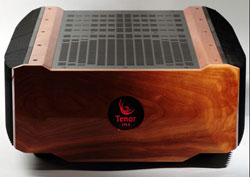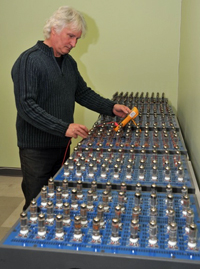 My first instalment, about a year ago, was about the Tenor power amplifier where I elaborated and talked about its sound. However, can't run an amp without a preamp — so I'd like to begin part 2 with a list of all the ones I had in-house at the time - the Tenor 175S My first instalment, about a year ago, was about the Tenor power amplifier where I elaborated and talked about its sound. However, can't run an amp without a preamp — so I'd like to begin part 2 with a list of all the ones I had in-house at the time - the Tenor 175S
I had the Allnic L-3000, a Magnum MD 309 (preamp section), an old modified Dolan and an Aesthetix Janus for my in-house auditions. I also used the Audio Aero Prestige CD player/preamp at my friend Sol's Tenor set-up. Each of these preamps has an attribute or unique sonic makeup that, in a good system arrangement, should be perceptible and reveal its degree of system synergy/compatibility. What came to light was that all harmonized well with the Tenor power amplifier. What I'm saying is that all preamps enabled me to hear the amplifier and its sonic distinction, though influenced by the various preamplifiers' personality/voice.
 First, the Allnic L-3000 preamp/Tenor combination. I had become very well acquainted with the Allnic's sonic personality, as I had tested it with various system configurations, but I was not prepared for the sonic merit and impact, when I introduced the Tenor power amp. Now, the musical value shot up tremendously. Earlier auditions of the Tenor monoblocks had familiarized me with the amp’s sonic character and I expected really good sound — and I got it all right; I recognized the amp’s sonic distinction immediately, which can only mean that the this preamp provided a relatively high level of neutrality. First, the Allnic L-3000 preamp/Tenor combination. I had become very well acquainted with the Allnic's sonic personality, as I had tested it with various system configurations, but I was not prepared for the sonic merit and impact, when I introduced the Tenor power amp. Now, the musical value shot up tremendously. Earlier auditions of the Tenor monoblocks had familiarized me with the amp’s sonic character and I expected really good sound — and I got it all right; I recognized the amp’s sonic distinction immediately, which can only mean that the this preamp provided a relatively high level of neutrality.
With the Magnum in the system, I also heard the sonic presence of the Tenor amp, this time, however, with a little less resolution, and added warmth — very pleasant sound,nevertheless.
The Dolan preamp was not a great match as it introduced a harder sound and offered less harmonic structure — not enough musical substance to engage an experienced listener.
The Aesthetics, on the other hand, rendered great harmonics, smooth-as-silk high frequencies and solid, resolute bass — I liked that combination a lot, and it engaged.
The Audio Aero Prestige preamp section — though a minimalistic approach in preamp design — managed the least audible presence within the system and provided the most transparent and rather impersonal/neutral musical information. This arrangement was the best for listening to the amplifier and its magnificent musicality.
In musical terms, most of the system combinations left nothing incomplete or unfinished and illustrated two points: three out of four preamplifiers were well suited for a refined-sounding amp such as the Tenor; and their own sonic signatures (slight, even welcomed colouration) added or imposed little damaging or deteriorating elements.
The bottom line: I believe that the Tenor calls for a very good preamplifier to get the most/best performance. Their own design certainly qualifies, but it is my opinion that a number of brands out there will match up very well.
A LITTLE TECH-TALK
The most interesting part of the Tenor amplifier's design is what head designer Michel did to eliminate audible distortion, which, by the way, is present in all amplifiers, preamplifiers and other electronic components, and can not be avoided altogether. Michel's objective wasn't to eliminate distortion, but to manage it so that the brain considers it as routine ear distortion, thus ignore it. Done the way Michel accomplished this, one gets to hear the original signal without ever becoming aware by what means, because it's an instinctual, subliminal activity. I asked for an explanation and was told (in a nutshell) that distortion — even the lowest claimed by manufacturers — is recognized by the brain, which can sense when something is wrong, may try to cancel it (distortion), but cannot. Michel states that a Tenor amplifier's distortion becomes inaudible to perceive— a claim to which I can attest, likely because I can't find any other reasonable rationale to justify the Tenor's knack to eclipse its presence and get out of the way in favour of the music it is asked to reproduce.
I'm not going to attempt to introduce you to the very complex methodology here, but instead come straight to the crux of the matter and say that Tenor's Michel has developed a very classified technology no other manufacturer has access to (it's called a trade secret) whereby distortion, while present, is inaudible — and the proof of the puddin' is — as it should be, in my opinion — in the listening experience, which has been described in part one.
 You should know that Tenor Audio has many quality control station where, tubes, circuit, wiring, resonance and finish undergoes fastidious testing without consideration of man-hours. There are many quality control stations where every part, indeed every bolt, is checked to assure a rigidly, high standard of quality. I had a tour of the plant and spoke with some of the engineers, but what really prompted my spirit of inquiry among these quality control stations was a small, nondescript box with a single speaker and an oscilloscope. It is used to check for tube noise — microphonincs. A faulty tube will alert with sound and the oscilloscope will show exactly where the tube fails. I have never seen this done. Before this routine, the tubes are burned in for 100 hours in a large 200 socked bed for the various tubes used in the design. In the final stage, each tube is measured then either used or, if not up to Tenor's standards, discarded. This careful selection process leads to the discarding of between 20 to 50 percent of all vacuum tube stock — that's rather costly, but does guarantee the highest quality. Discarded tubes (and other components) are either sent back to the manufacturers or sold off (yes, I understand that others will use them). You should know that Tenor Audio has many quality control station where, tubes, circuit, wiring, resonance and finish undergoes fastidious testing without consideration of man-hours. There are many quality control stations where every part, indeed every bolt, is checked to assure a rigidly, high standard of quality. I had a tour of the plant and spoke with some of the engineers, but what really prompted my spirit of inquiry among these quality control stations was a small, nondescript box with a single speaker and an oscilloscope. It is used to check for tube noise — microphonincs. A faulty tube will alert with sound and the oscilloscope will show exactly where the tube fails. I have never seen this done. Before this routine, the tubes are burned in for 100 hours in a large 200 socked bed for the various tubes used in the design. In the final stage, each tube is measured then either used or, if not up to Tenor's standards, discarded. This careful selection process leads to the discarding of between 20 to 50 percent of all vacuum tube stock — that's rather costly, but does guarantee the highest quality. Discarded tubes (and other components) are either sent back to the manufacturers or sold off (yes, I understand that others will use them).
The end product— the fully assembled unit — when delivered, has been put to many tests and put through its paces, operated, checked, examined, assessed, evaluated, appraised, investigated, analysed, scrutinized and studied. What the customer gets is a finely tuned instrument that will maintain specifications and peak performance for well over 12,000 hours of operation — my unit had over 10,000 hours of play when I received it and I added another 2000 hours; after my use it went back to the factory to be examined. The prognosis after I have had the amp in my house for about one year: STILL UP TO SPECIFICATIONS INCLUDING ALL TUBES.
SYNOPSIS
Expensive? Yes — but by no means the most expensive, some of which I have seen and heard. I believe that the price of the amplifier is warranted and fair, and I give you my reasoning for this inference:
In my almost 30 years as a reviewer, I have listened to some outstanding and great-sound amplifier designs. Fact is, I have loved some, I have lusted after some, I have lived a harmonious life with some — BUT, if I had to marry one, it would only be the Tenor. What more is there say…
|
Technology Overview
The Tenor amplifiers are OTL (output transformer less) designs at the input stage. They operate in Class A at a high operating voltage. The signal is then going to a big solid state circuit, working in unity-gain mode, without voltage amplification. This section has been designed to provide current only whereas the amplification is the vacuum tube domain.
Gain: 32dB RCA/30dB XLR
Power: 2, 4, 8 (1 kHz): 650, 350, 175W
Signal to noise ratio (10W*): -94dBA
Signal to noise ratio (full power*): -115dBA
Frequency response: 3-200 000Hz (± 3dB)
THD + N (5W/20-20kHz): < 0.10%
Channel crosstalk (1kHz): < -100dB
Input impedance (1kHz; XLR/RCA): 20k/33k
Output impedance*: 0.16
Damping factor*: 50
Working in class A: 13W *
Input sensitivity (175W, 8, 1kHz): 1.3V XLR/1.5V RCA
Maximum power consumption: 1850W
Dimensions: 710 x 500 x 210mm
Weight: 53.5kg
THD + N (10W): < 0.08%*
THD + N (175W): < 0.25%*
IMD SMPTE (10W): < 0.5% |
